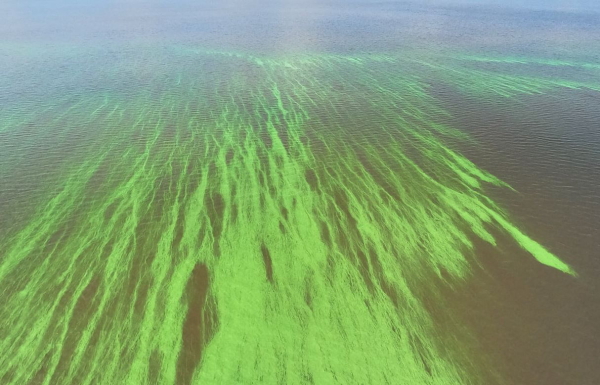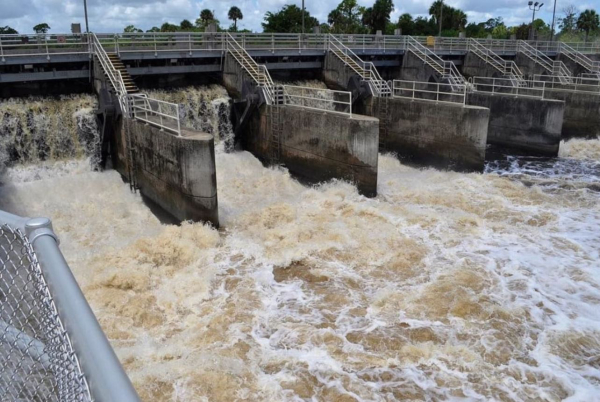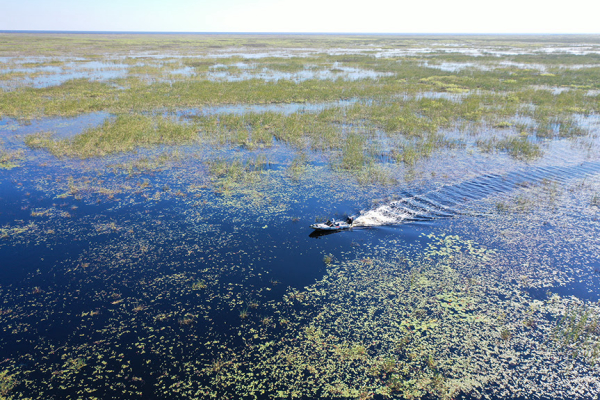
Some 40 years ago, the Indian River Lagoon, stretching along some 40 percent of the entire eastern shore of Florida, was an angler’s paradise.
Around the Stuart area, you could wade in knee deep water and with some regularity catch sea trout of 7 pounds and more, and there seemed to be endless numbers of 5 to 6 pound snook along with some battle-scarred monsters of 20 pounds and more—and even a bunch of trampolineing junior-sized tarpon there for the dance. The water was clear and almost the entire floor of the lagoon was carpeted in healthy seagrasses and shellfish.
At Cocoa Beach, the big trout were also there, along with thousands of keeper-size—catching 100 a day was not uncommon for experienced anglers. The trout were joined by schools of monster redfish to 40 inches long. The adult reds lived inside the shallow bay their entire lives, unlike adults in most areas which head off the beaches as they mature.
No more.
Things went sour first at the mouth of the St. Lucy Canal, likely result of foamy brown polluted water pouring out of Lake Okeechobee. But soon issues spread everywhere there was a waterfront trailer park with septic tanks leaching into the estuary or luxury homes with rich yards kept green with loads of weed killer and fertilizer, which also found its way into the river.

The water became cloudy, vast algae blooms turned the water pea green, the seagrasses and shellfish died, and the fish all but disappeared over thousands of acres of shallows.
The St. Johns Water Management District (SJWMD) is among the state and local agencies charged with sorting out the mess. The District monitors seagrass growth, conducting visual assessments and official mapping every two years. Data collected in the summer of 2023 revealed an increase in seagrass extent since 2021, particularly in the northern IRL and southern Mosquito Lagoon. Additionally, in-water surveys conducted in January and February 2024 noted natural seagrass recruitment in the Banana River Lagoon and northern IRL, where waters have cleared somewhat.
That’s the good news. But challenges persist. The seagrass in the southern lagoon experienced a slight decline. District scientists say the shallower waters of the northern lagoon play a significant role, allowing light to reach seagrasses and stimulate growth. Additionally, this area appears to host a richer seed source, enhancing the natural recruitment observed in recent surveys.
Since 2019, Florida Governor Ron DeSantis, a Republican with a strong interest in the state’s natural habitat, has committed nearly $390 million to enhance water quality in the region, including $100 million annually to fund projects dedicated to restoring the IRL. This infusion of state funding, combined with collaborative partnerships, is proving instrumental in revitalizing the lagoon, per SJWMD.
Nearly 70 water quality improvement projects are in varying stages of progress along the lagoon. These projects encompass a diverse array of initiatives, ranging from the connection of septic tanks to central sewer systems to the enhancement of wastewater treatment facilities, reducing the harmful nutrients entering the waterway.

What can individual residents do to help?
The state says following what they call “Florida-Friendly Landscaping” can be a big step. This includes using only native plants in landscaping, water conservation, responsible and minimal fertilization and reducing stormwater runoff.
Basically it’s the same problem seen on many waters nationwide, too much replacement of natural shoreline, marsh and wetland habitat with developments. But Florida has it in spades due to 1,000 new residents moving in every day.
There’s no quick solution for curing the IRL but at least the state has pinpointed the problems and is taking steps to reduce them within the confines of existing development. Combined with the massive state/federal efforts to send the high-nutrient water from Lake Okeechobee into the Everglades rather than to the state’s east and west coasts, it may bring an eventual restoration of at least some of the lost glory.
For more on the St. Johns WMD efforts, go here: www.sjrwmd.com/waterways/renew-lagoon.
Frank Sargeant
Frankmako1@gmail.com
